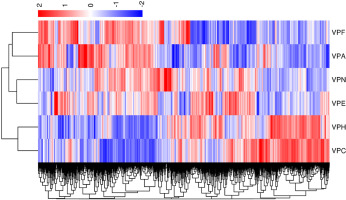当前位置:
X-MOL 学术
›
Phytochemistry
›
论文详情
Our official English website, www.x-mol.net, welcomes your
feedback! (Note: you will need to create a separate account there.)
Transcriptome profiling of two Dactylis glomerata L. cultivars with different tolerance in response to submergence stress
Phytochemistry ( IF 3.2 ) Pub Date : 2020-07-01 , DOI: 10.1016/j.phytochem.2020.112378 Bing Zeng 1 , Yajie Zhang 1 , Ailing Zhang 2 , Dandan Qiao 1 , Juncai Ren 1 , Mingyang Li 1 , Kai Cai 1 , Jinhua Zhang 3 , Linkai Huang 2
Phytochemistry ( IF 3.2 ) Pub Date : 2020-07-01 , DOI: 10.1016/j.phytochem.2020.112378 Bing Zeng 1 , Yajie Zhang 1 , Ailing Zhang 2 , Dandan Qiao 1 , Juncai Ren 1 , Mingyang Li 1 , Kai Cai 1 , Jinhua Zhang 3 , Linkai Huang 2
Affiliation

|
Submergence is one of the environmental stresses that limit plant growth and development. Dactylis glomerata L. is an important cool-season forage grass globally. To investigate the genes related to submergence response and the molecular mechanism associated with submergence tolerance, the transcriptome of D. glomerata in response to waterlogging treatment was analyzed. RNA-sequencing was performed in two D. glomerata cultivars, submergence tolerant 'Dianbei' and submergence sensitive 'Anba'. A total of 50,045 unique genes matched the known proteins in the NCBI nr database by BLAST searches and 60.8% (30,418) of these genes were annotated with GO terms. Among these, 1395 genes only differentially expressed in 'Dianbei' and 18 genes shown different expression all the time were detected between the submergence tolerant 'Dianbei' and sensitive 'Anba'. Gene ontology (GO) and KEGG pathway enrichment analyses demonstrated that the DEGs were mainly implicated in oxidation-reduction system, nucleic acid binding transcription factor activity, and glycerol kinase activity. The D. glomerata assembled transcriptome provided substantial molecular resource for further genomic analysis of forage grasses in response to submergence stress. The significant difference in expression of specific unigenes may account for waterlogging tolerance or acclimation in the two different D. glomerata cultivars. This study provided new insights into the molecular basis of submergence tolerance in D. glomerata.
中文翻译:

对淹没胁迫响应具有不同耐受性的两个 Dactylis glomerata L. 品种的转录组分析
淹没是限制植物生长和发育的环境压力之一。Dactylis glomerata L. 是全球重要的冷季牧草。为了研究与淹没响应相关的基因和与淹没耐受性相关的分子机制,分析了 D. glomerata 对涝渍处理的转录组。RNA 测序是在两个 D. glomerata 栽培品种中进行的,耐浸'滇贝'和浸水敏感的'安霸'。通过 BLAST 搜索,共有 50,045 个独特基因与 NCBI nr 数据库中的已知蛋白质相匹配,其中 60.8% (30,418) 的基因用 GO 术语进行注释。其中,1395个基因仅在'滇贝'中差异表达,18个基因在耐淹'之间一直表现出不同的表达。电贝'和敏感的'安霸'。基因本体 (GO) 和 KEGG 通路富集分析表明,DEG 主要与氧化还原系统、核酸结合转录因子活性和甘油激酶活性有关。D. glomerata 组装的转录组为响应淹没压力的牧草的进一步基因组分析提供了大量的分子资源。特定 unigenes 表达的显着差异可能解释了两种不同 D. glomerata 栽培品种的耐涝或适应能力。这项研究为球藻耐水的分子基础提供了新的见解。基因本体 (GO) 和 KEGG 通路富集分析表明,DEG 主要与氧化还原系统、核酸结合转录因子活性和甘油激酶活性有关。D. glomerata 组装的转录组为响应淹没压力的牧草的进一步基因组分析提供了大量的分子资源。特定 unigenes 表达的显着差异可能解释了两种不同 D. glomerata 栽培品种的耐涝或适应能力。这项研究为球藻耐水的分子基础提供了新的见解。基因本体 (GO) 和 KEGG 通路富集分析表明,DEG 主要与氧化还原系统、核酸结合转录因子活性和甘油激酶活性有关。D. glomerata 组装的转录组为响应淹没压力的牧草的进一步基因组分析提供了大量的分子资源。特定 unigenes 表达的显着差异可能解释了两种不同 D. glomerata 栽培品种的耐涝或适应能力。这项研究为球藻耐水的分子基础提供了新的见解。glomerata 组装的转录组为响应淹没压力的牧草的进一步基因组分析提供了大量的分子资源。特定 unigenes 表达的显着差异可能解释了两种不同 D. glomerata 栽培品种的耐涝或适应能力。这项研究为球藻耐水的分子基础提供了新的见解。glomerata 组装的转录组为响应淹没压力的牧草的进一步基因组分析提供了大量的分子资源。特定 unigenes 表达的显着差异可能解释了两种不同 D. glomerata 栽培品种的耐涝或适应能力。这项研究为球藻耐水的分子基础提供了新的见解。
更新日期:2020-07-01
中文翻译:

对淹没胁迫响应具有不同耐受性的两个 Dactylis glomerata L. 品种的转录组分析
淹没是限制植物生长和发育的环境压力之一。Dactylis glomerata L. 是全球重要的冷季牧草。为了研究与淹没响应相关的基因和与淹没耐受性相关的分子机制,分析了 D. glomerata 对涝渍处理的转录组。RNA 测序是在两个 D. glomerata 栽培品种中进行的,耐浸'滇贝'和浸水敏感的'安霸'。通过 BLAST 搜索,共有 50,045 个独特基因与 NCBI nr 数据库中的已知蛋白质相匹配,其中 60.8% (30,418) 的基因用 GO 术语进行注释。其中,1395个基因仅在'滇贝'中差异表达,18个基因在耐淹'之间一直表现出不同的表达。电贝'和敏感的'安霸'。基因本体 (GO) 和 KEGG 通路富集分析表明,DEG 主要与氧化还原系统、核酸结合转录因子活性和甘油激酶活性有关。D. glomerata 组装的转录组为响应淹没压力的牧草的进一步基因组分析提供了大量的分子资源。特定 unigenes 表达的显着差异可能解释了两种不同 D. glomerata 栽培品种的耐涝或适应能力。这项研究为球藻耐水的分子基础提供了新的见解。基因本体 (GO) 和 KEGG 通路富集分析表明,DEG 主要与氧化还原系统、核酸结合转录因子活性和甘油激酶活性有关。D. glomerata 组装的转录组为响应淹没压力的牧草的进一步基因组分析提供了大量的分子资源。特定 unigenes 表达的显着差异可能解释了两种不同 D. glomerata 栽培品种的耐涝或适应能力。这项研究为球藻耐水的分子基础提供了新的见解。基因本体 (GO) 和 KEGG 通路富集分析表明,DEG 主要与氧化还原系统、核酸结合转录因子活性和甘油激酶活性有关。D. glomerata 组装的转录组为响应淹没压力的牧草的进一步基因组分析提供了大量的分子资源。特定 unigenes 表达的显着差异可能解释了两种不同 D. glomerata 栽培品种的耐涝或适应能力。这项研究为球藻耐水的分子基础提供了新的见解。glomerata 组装的转录组为响应淹没压力的牧草的进一步基因组分析提供了大量的分子资源。特定 unigenes 表达的显着差异可能解释了两种不同 D. glomerata 栽培品种的耐涝或适应能力。这项研究为球藻耐水的分子基础提供了新的见解。glomerata 组装的转录组为响应淹没压力的牧草的进一步基因组分析提供了大量的分子资源。特定 unigenes 表达的显着差异可能解释了两种不同 D. glomerata 栽培品种的耐涝或适应能力。这项研究为球藻耐水的分子基础提供了新的见解。











































 京公网安备 11010802027423号
京公网安备 11010802027423号